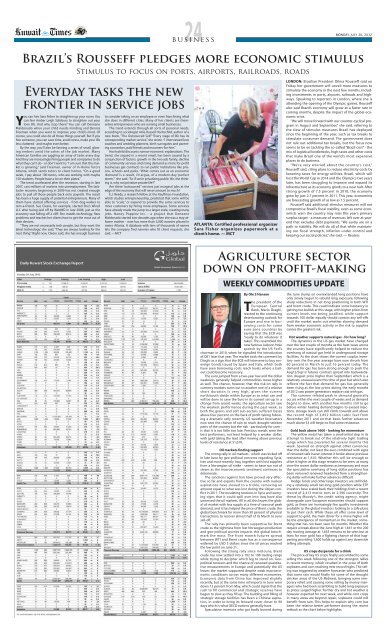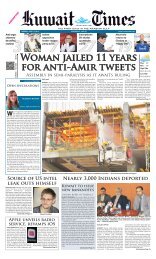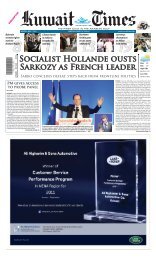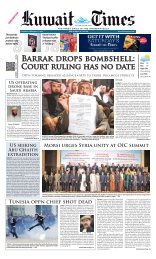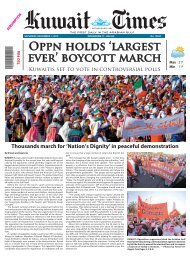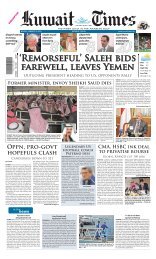UAE widENS cRAckdOwN; MORE ISlAMiStS ... - Kuwait Times
UAE widENS cRAckdOwN; MORE ISlAMiStS ... - Kuwait Times
UAE widENS cRAckdOwN; MORE ISlAMiStS ... - Kuwait Times
Create successful ePaper yourself
Turn your PDF publications into a flip-book with our unique Google optimized e-Paper software.
Y ou<br />
24 business<br />
MONDAY, JULY 30, 2012<br />
Brazil’s Rousseff pledges more economic stimulus<br />
Everyday tasks the new<br />
frontier in service jobs<br />
can hire Sara Fisher to straighten up your room. You<br />
can hire Amber Leigh Salisbury to straighten out your<br />
love life. And why stop there? You can call Deneane<br />
Maldonado when your child needs minding and Dennis<br />
Freeman when you want to improve your child’s mind. Of<br />
course, you could also do all those things yourself. But if you<br />
hire someone, you can save time, avoid stress, make your life<br />
less cluttered - and maybe even better.<br />
By the way, you’ll also be fanning a series of small, glowing<br />
embers amid the ashes of the job market. Many<br />
American families are juggling an array of tasks every day.<br />
And they are increasingly hiring people and companies to do<br />
what they can’t do - or don’t want to. “I am sure that the market<br />
is growing,” said Freeman, owner of In-Home Tutors<br />
Atlanta, which sends tutors to client homes. “On a good<br />
week, I pay about 100 tutors, who are working with maybe<br />
150 students. People have a lot on their plates.”<br />
The trend accelerated after the recession, starting in late<br />
2007, cast millions of workers into unemployment. The lackluster<br />
recovery beginning in 2009 has not created enough<br />
jobs to pull all those people back onto payrolls. The result<br />
has been a huge supply of potential entrepreneurs. Many of<br />
them have started offering services - from dog-walker to<br />
rent-a-friend. Sue Cleere, for example, started She’s Wired<br />
LLC after being laid off by WebMD in late 2008, just as the<br />
economy was falling off a cliff. She installs technology, fixes<br />
problems and teaches her clients how to get the most out of<br />
their devices.<br />
“They are not necessarily tech people, but they want the<br />
latest technology,” she said. “They are always looking for the<br />
next thing.” Right now, Cleere said, she has enough business<br />
Stimulus to focus on ports, airports, railroads, roads<br />
to consider taking on an employee or even franchising what<br />
she does in different cities. Many of her clients are themselves<br />
entrepreneurs who are running small businesses.<br />
The trend extends through all sorts of personal needs,<br />
according to sociologist Arlie Russell Hochschild, author of a<br />
new book, “The Outsourced Self.” “Every stage of life has its<br />
corresponding market service,” she wrote. “I interviewed love<br />
coaches and wedding planners, birth surrogates and parenting<br />
counselors, paid friends and mourners-for-hire.”<br />
Hochschild discounts narrow economic explanations. The<br />
trend, she argued in a recent email, has been caused by a<br />
conjunction of factors: growth in the two-job family, decline<br />
of community services and rising demand as more for-profit<br />
businesses get contracts to run public institutions like prisons,<br />
schools and parks. “What comes out as an economic<br />
‘demand’ is a result, I’d argue, of a modern-day ‘perfect<br />
storm,’ “ she said. “So if we’re privatizing public life, the thinking<br />
is, why not privatize private life?”<br />
Are these “outsourced” services just marginal jobs at the<br />
edge of the economy that will never amount to much?<br />
E.J. Reedy, a research fellow at the Kauffman Foundation,<br />
which studies entrepreneurship, predicted that some will be<br />
able to “scale,” or expand to provide the same services to<br />
more customers by hiring more employees. Some services<br />
have already made the jump to a larger scale, creating many<br />
jobs. Nanny Poppinz Inc. - a project that Deneane<br />
Maldonado started two decades ago when she was a stay-athome<br />
mother - now has more than 3,000 nannies placed in<br />
metro Atlanta. A database with tens of thousands of names<br />
lets the company find nannies who fit client requests, she<br />
said. —MCT<br />
ATLANTA: Certified professional organizer<br />
Sara Fisher organizes paperwork at a<br />
client’s home. — MCT<br />
LONDON: Brazilian President Dilma Rousseff said on<br />
Friday her government will unveil more measures to<br />
stimulate the economy in the next few months, including<br />
investments in ports, airports, railroads and highways.<br />
Speaking to reporters in London, where she is<br />
attending the opening of the Olympic games, Rousseff<br />
also said Brazil’s economy will grow at a faster rate in<br />
coming months, despite the impact of the global economic<br />
crisis.<br />
“We will move forward with our counter-cyclical program<br />
in August and September,” she said, referring to<br />
the slew of stimulus measures Brazil has deployed<br />
since the beginning of the year, such as tax breaks to<br />
stimulate consumer demand. The government does<br />
not rule out additional tax breaks, but the focus now<br />
seems to be on tackling the so-called “Brazil cost” - the<br />
mix of logistical bottlenecks, high taxes and other costs<br />
that make Brazil one of the world’s most expensive<br />
places to do business.<br />
“We’re very worried about the country’s cost,”<br />
Rousseff said, citing plans to reduce electricity costs by<br />
lowering taxes for energy utilities. Brazil, which will<br />
host the World Cup in 2014 and the Olympics two years<br />
later, has been struggling to improve and expand its<br />
infrastructure as its economy grinds to a near halt. After<br />
strong growth of 7.5 percent in 2010, the economy<br />
grew by just 2.7 percent in 2011. This year, economists<br />
are forecasting growth of as low as 1.5 percent.<br />
Rousseff said additional stimulus measures will not<br />
compromise Brazil’s fiscal stability, even as some economists<br />
warn the country may miss this year’s primary<br />
surplus target - a measure of revenues left over at yearend<br />
that excludes debt payments. “We surely are on a<br />
path to stability. We will do all of that while maintaining<br />
our fiscal strength, inflation under control and<br />
keeping our social policies,” she said. — Reuters<br />
Agriculture sector<br />
down on profit-making<br />
WEEKLY COMMODITIES UPDATE<br />
By Ole S Hansen<br />
T he<br />
president of the<br />
European Central<br />
Bank, Mario Draghi,<br />
reacted to the continuing<br />
deteriorating outlook for<br />
Europe and rise in borrowing<br />
costs for some<br />
euro-zone countries by<br />
saying that the ECB was<br />
“ready to do whatever it<br />
takes”. This resembled the<br />
now famous Jackson Hole<br />
speech by the US Fed’s<br />
chairman in 2010, when he signalled the introduction<br />
of QE1 later that year. The market took the comment by<br />
Draghi as a sign that the ECB will intervene to buy sovereign<br />
bonds issued by Spain and Italy, which both<br />
have seen borrowing costs reach levels where a bailout<br />
could become necessary.<br />
The euro jumped from a two-year low and the dollar<br />
weakness generally helped commodities move higher<br />
as well. The chance, however, that this risk-on rally in<br />
currency markets turns out to another one of a relative<br />
short duration is very high, given the current<br />
north/south divide within Europe as to what can and<br />
will be done to save the Euro in its current set-up. In a<br />
change from recent weeks, the agriculture sector saw<br />
the weakest performance during the past week, as<br />
both the grains and soft sub-sectors suffered losses<br />
above four percent on the back of profit taking following<br />
a dramatic rally recently. US weather forecasters<br />
now sees the chance of rain to reach drought-stricken<br />
parts of the country but the risk - particularly for corn -<br />
is that it is too little too late. Precious metals were the<br />
best performers, not least helped by a weaker dollar,<br />
with gold taking the lead after moving above previous<br />
levels of resistance at $1,610.<br />
Oil markets finding support<br />
The strong rally in oil markets - which was kicked off<br />
in late June by geo-political concerns regarding Syria,<br />
Iran and most recently Iraq, together with lost supplies<br />
from a Norwegian oil strike - seems to have run out of<br />
steam as the macroeconomic sentiment continues to<br />
deteriorate.<br />
The sanctions against Iran have proved very effective<br />
so far and exports from the country with nuclear<br />
aspirations have slowed to a trickle, removing an<br />
amount equal to what was lost during the Libyan conflict<br />
in 2011. The escalating tensions in Syria and worrying<br />
signs that it could spill over into Iraq have also<br />
unnerved the oil markets. All in all, this leaves the global<br />
oil market with less supply at a time of seasonal peak<br />
demand, and it has helped the price of Brent crude, the<br />
global benchmark for more than 50 percent of physical<br />
transactions, to recover almost half of its March to June<br />
sell-off.<br />
The rally has primarily been supportive for Brent<br />
crude as the tightness from lost Norwegian production<br />
and geo-political worries impacts this global benchmark<br />
the most. The front month futures spread<br />
between WTI and Brent crude has as a consequence<br />
widened by USD 5 dollars since the oil prices reached<br />
the low point on June 21.<br />
Following the strong rally since mid-June, Brent<br />
crude has now settled into a 102 to 108 trading range<br />
while trying to decipher which leg to stand on. Geopolitical<br />
tensions and the chance of renewed quantitative<br />
measurements in Europe and potentially the US<br />
leaves the market supported despite weak macroeconomic<br />
conditions across many different economies.<br />
Economic data from China has improved slightly<br />
recently, but at the same time oil imports in June were<br />
down 12 percent from May, which could signal that the<br />
rush to fill commercial and strategic reserves have<br />
begun to slow as they fill up. The building and filling of<br />
strategic storage facilities has been a Chinese aspiration,<br />
in order to bring its forward cover closer to 90<br />
days which is what OECD nations generally have.<br />
Speculative investors who got badly burned during<br />
the June slump on overextended long positions have<br />
only slowly begun to rebuild long exposure, following<br />
sharp reductions in net-long positioning in both WTI<br />
and brent crude. This could indicate some hesitancy in<br />
getting too bullish at this stage, with higher prices from<br />
current levels not being justified, while support<br />
towards 100 dollar equally should contain any sell-offs<br />
until the market works out whether slowing demand<br />
from weaker economic activity or the risk to supplies<br />
carries the greatest risk.<br />
Hot weather supports natural gas - for how long?<br />
The dynamics in the US gas market have changed<br />
over the last couple of months as the heat wave across<br />
the country have significantly helped to reduce the<br />
overhang of natural gas held in underground storage<br />
facilities. As the chart shows the current surplus inventory<br />
over the five year average have now shrunk from<br />
60 percent in March to just 16 percent today. The<br />
demand for gas has been strong enough to push the<br />
Aug12/Sep12 futures contract spread into backwardation<br />
(August price higher than September) which is a<br />
relatively unusual event this time of year but which also<br />
reflects the fact that demand for gas has generally<br />
been rising as the low prices during the early months<br />
of 2012 saw power generators replace coal with gas.<br />
The summer related peak in demand generally<br />
occurs within the next couple of weeks and as demand<br />
begins to slow, with another few months still to go<br />
before winter heating demand begins to exceed injections,<br />
storage levels can still climb towards and above<br />
the record high of 3,852 billion cubic feet from<br />
November 2011 and on that basis further advances<br />
much above $3 will begin to find some resistance.<br />
Gold back above 1600 - looking for momentum<br />
The yellow metal has taken a small initial step in its<br />
attempt to break out of the relatively tight trading<br />
range which has prevailed for several months this<br />
week. Spurred on strength against other currencies<br />
than the dollar, not least the euro combined with signs<br />
of renewed safe-haven interest it broke above previous<br />
resistance at 1,610. Whether this will be enough to<br />
drive it higher at this stage remains to be seen, as many<br />
view the recent dollar weakness as temporary and once<br />
the speculative overhang of long dollar positions has<br />
been removed renewed headwind from a strengthening<br />
dollar will make further advances difficult.<br />
Hedge funds and other large investors are still holding<br />
a relatively small net-long gold position while ETP<br />
investors have scaled back their holdings from a recent<br />
record of 2,413 metric tons to 2,396 currently. The<br />
threat by Moody’s, the credit rating agency, might<br />
downgrade core European economies should support<br />
gold, as there are increasingly few quality investments<br />
available to the global investors looking to a safe place<br />
to put their cash. While these all offer some level of<br />
support to gold, the main driver for a move higher will<br />
be the emergence of momentum in the market, something<br />
that has not been seen for months. Whether this<br />
require a break above the June high at 1,641 or the 200<br />
day moving average at 1,655 remains to be seen but at<br />
least for now gold has a fighting chance of that happening<br />
providing 1,600 holds up against any downside<br />
selling attempts.<br />
US crops desperate for a drink<br />
The price of key US crops finally succumbed to some<br />
selling this week following one of the strongest rallies<br />
in recent memory, which resulted in the price of both<br />
soybeans and corn reaching new record highs. The selling<br />
was triggered by weather forecaster who predicted<br />
that some rain would finally hit some of the drought<br />
stricken areas of the US Midwest, bringing some temporary<br />
relief, and causing some selling by money managers<br />
who had been scrambling to build long exposure<br />
as prices surged higher. Further dry and hot weather is<br />
however expected for next week, and while corn crops<br />
in many areas are beyond repair, soybeans could still<br />
benefit from rain. This helps to explain why corn has<br />
been the relative better performer during the recent<br />
setback as the chart below highlights.


